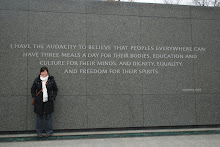One of the TOUGHEST days on the Camino for me. Not just because it was raining buckets all day. Not just because the famous wine fountain of Irache with free wine for pilgrims was closed (below), and not because Rachel forgot our goat cheese at the Albergue (I promise that before I die, I will forget that ever happened). I just wasn't fully awake and focused mentally, and it was one of those days when the reasons why I am on this pilgrimage seemed empty. I missed family and friends and wished for "normal" life when I don't have to get up early to trudge through the mud for 6-7 hours, then wash, eat, sleep and repeat.
Day 22-23. Logrono and Ventosa.
Yesterday's doldrums were gone somehow when I awoke to rain on what would be our longest day yet - 30ish km, about 18 miles. Rachel and I sang a lot on the trail, which helped lift our mood and give us energy. And at a certain point, I stopped caring that my pants and feet were soaked. We met up with some pilgrim friends from Argentina, South Africa, and Orange County (isn't that a separate country?), and went out for tapas that evening in the beautiful city of Logrono, which was celebrating its patron saint. We went to bed at 9:30, just as the festividades were starting! The mural below says "El Camino de Santiago se hace por (E)Tapas," jeje.
Day 24. Santo Domingo de Calzada.
Today was a strange day. We walked about 7 hours and reached a mostly abandoned housing development at the top of a hill with an empty golf course and for sale signs everywhere. It was like something out of the surreal suburbs of Phoenix - pavement and tract housing and fake landscape. Tired, we looked for an Albergue listed in our guidebook called the Virgen de Guadalupe. We knocked and knocked and finally a man opened the door with a loud "SI?!" As soon as we stepped inside, Rachel and I both felt creeped out. No one else was there. The man said it would be 13 Euros each, twice what we usually paid for a place. We peeked into the dark kitchen and bedrooms and all the while, the bad feeling grew. I looked at Rachel and without even talking, we decided to get out of there. It was another 6 km until the next village, but we were glad we trusted our intuition!
Rachel even picked up dinner along the way (below). Just kidding, the church in the town we stayed in is famous for a legend involving a chicken.
Day 25. Belorado
Today was a wonderful time of serendipitously running into friends we had met along the way. One of these was Ann-Dominique. I told her she was the funniest, most genial French woman we had ever met. Ann spoke only French, but I felt an instant connection with her. She is hiking the Camino as a retreat to have some time to herself (context: she has 6 children to care for at home), to see who God brings her way each day, and to pray. One gets the feeling around Ann that she must be close to God because of the warmth of love and joy that radiates from her. She showed me much of the Mother's tenderness and light, and even though we probably talked for only 4 or 5 hours total, we were all in tears when we had to say goodbye.
Day 26-27. Ages-Burgos
Last days on the Camino! We ran into a mother and daughter who were not doing so well relationally when we first met them in the beginning of the trail - people say to be careful who you hike with - and I thought about them often as we hiked. They were committed to finishing, though, and the daughter said she wanted the Camino to be a way to reconcile with her mom, who she had a painful history with. Praying for a break through for them!
I left them feeling thankful for walking with Rachel. Though we saw the worst in each other at times, we also learned to depend on one another, communicate better, see the best in each other, and show love through small acts like washing the others' clothes, changing how we would normally do things, or letting the other person shower first.
I'm sure I will have more thoughts on finishing the Camino and what it meant, but for now I am glad to have made it, glad for a stronger friendship with my sister, and glad to be coming home in a few days!
Ours were the last shoes on the shelf at the Albergue today - the journey is over for now!


















